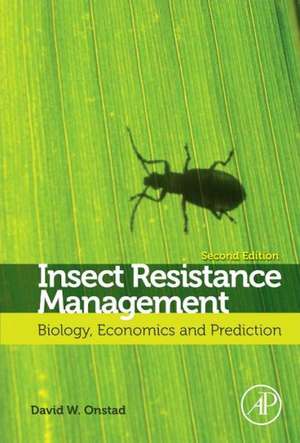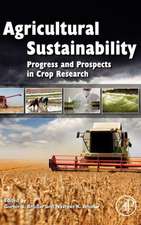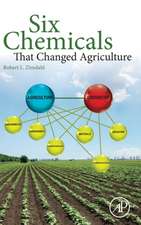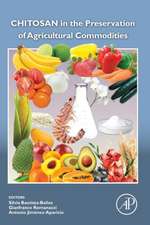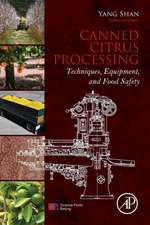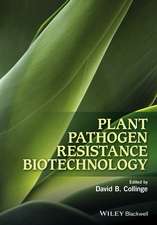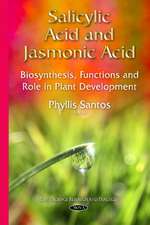Insect Resistance Management: Biology, Economics, and Prediction
Editat de David W. Onstaden Limba Engleză Hardback – 22 oct 2013
Many new ideas, facts and case studies have been developed since the previous edition of Insect Resistance Management published. With a new chapter focusing on Resistance Mechanisms Related to Plant-incorporated Toxins and heavily expanded revisions of several existing chapters, this new volume will be an invaluable resource for IRM researchers, practitioners, professors and advanced students. Authors in this edition include professors at major universities, leaders in the chemical and seed industry, evolutionary biologists and active IRM practitioners. This revision also contains more information about IRM outside North America, and a modeling chapter contains a large new section on uncertainty analysis, a subject recently emphasized by the U.S. Environmental Protection Agency. The final chapter contains a section on insecticidal seed treatments.
No other book has the breadth of coverage of Insect Resistance Management, 2e. It not only covers molecular to economic issues, but also transgenic crops, seed treatments and other pest management tactics such as crop rotation. Major themes continuing from the first edition include the importance of using IRM in the integrated pest management paradigm, the need to study and account for pest behavior, and the influence of human behavior and decision making in IRM.
- Provides insights from the history of insect resistance management (IRM) to the latest science
- Includes contributions from experts on ecological aspects of IRM, molecular and population genetics, economics, and IRM social issues
- Offers biochemistry and molecular genetics of insecticides presented with an emphasis on recent research
- Encourages scientists and stakeholders to implement and coordinate strategies based on local social conditions
| Toate formatele și edițiile | Preț | Express |
|---|---|---|
| Hardback (2) | 420.95 lei 5-7 săpt. | |
| ELSEVIER SCIENCE – 4 dec 2007 | 0.00 lei Indisponibil | |
| ELSEVIER SCIENCE – 22 oct 2013 | 420.95 lei 5-7 săpt. |
Preț: 420.95 lei
Preț vechi: 573.53 lei
-27% Nou
Puncte Express: 631
Preț estimativ în valută:
80.56€ • 83.47$ • 67.23£
80.56€ • 83.47$ • 67.23£
Carte tipărită la comandă
Livrare economică 14-28 martie
Preluare comenzi: 021 569.72.76
Specificații
ISBN-13: 9780123969552
ISBN-10: 0123969557
Pagini: 560
Dimensiuni: 152 x 229 x 38 mm
Greutate: 0.93 kg
Ediția:2. Auflage.
Editura: ELSEVIER SCIENCE
ISBN-10: 0123969557
Pagini: 560
Dimensiuni: 152 x 229 x 38 mm
Greutate: 0.93 kg
Ediția:2. Auflage.
Editura: ELSEVIER SCIENCE
Public țintă
Pest control, crop science, agricultural economics researchers and scientists; entomologists; agricultural engineers; plant scientists; graduate-level studentsCuprins
1. Major Issues in Insect Resistance Management
2. Valuing Pest Susceptibility to Control
3. Understanding Resistance and Induced Responses of Insects to Xenobiotics and Insecticides in the Age of "Omics" and Systems Biology
4. Resistance Mechanisms Related to Plant-incorporated Toxins
5. Concepts and Complexities of Population Genetics
6. Resistance by Ectoparasites
7. Insect Resistance to Crop Rotation
8. Arthropod Resistance to Crops
9. The Role of Landscapes in Insect Resistance Management
10. Negative Cross-Resistance: History, Present Status, and Emerging Opportunities
11. The Roles of Natural Enemies and Density-Dependent Mortality in Resistance Management
12. Insect Resistance Management: Adoption and Compliance
13. Modeling for Prediction and Management
14. Monitoring Resistance
15. IPM and Insect Resistance Management
2. Valuing Pest Susceptibility to Control
3. Understanding Resistance and Induced Responses of Insects to Xenobiotics and Insecticides in the Age of "Omics" and Systems Biology
4. Resistance Mechanisms Related to Plant-incorporated Toxins
5. Concepts and Complexities of Population Genetics
6. Resistance by Ectoparasites
7. Insect Resistance to Crop Rotation
8. Arthropod Resistance to Crops
9. The Role of Landscapes in Insect Resistance Management
10. Negative Cross-Resistance: History, Present Status, and Emerging Opportunities
11. The Roles of Natural Enemies and Density-Dependent Mortality in Resistance Management
12. Insect Resistance Management: Adoption and Compliance
13. Modeling for Prediction and Management
14. Monitoring Resistance
15. IPM and Insect Resistance Management
Recenzii
"...good editing has ensured a consistent writing style and prevented excess repetition. Also, the cross-referencing between the chapters helps tie them together. Nevertheless, the chapters stand very well on their own…a very readable prose." --Bulletin of the ESC
"This updated edition…is an excellent overview of IRM; hopefully, future researchers will work closely with plant pathologists, plant breeders, and even medical scientists struggling with very similar issues plaguing society that appear to stem from very similar biological processes. Summing Up: Highly recommended." --CHOICE, July 2014
"…recent advances in this dynamic field are well documented and explained in the second edition of the book…easy to read and the language is very accessible to non-specialists, so it should be considered a very valuable reference for students and professional researchers interested in IRM, including insect pathologists involved in the use of entomopathogens for pest control." --Society for Invertebrate Pathology Newsletter, June 2014
"Contributors from entomology, agriculture, and economics explore aspects of managing insect resistance to pesticides, reporting their own results, reviewing those of others, and offering practical suggestions for applying them. Among the topics are understanding resistance and induced responses of insects to xenobiotics and insecticides in the age of "omics" and systems biology, concepts and complexities of population genetics,…" --ProtoView.com, February 2014
"This updated edition…is an excellent overview of IRM; hopefully, future researchers will work closely with plant pathologists, plant breeders, and even medical scientists struggling with very similar issues plaguing society that appear to stem from very similar biological processes. Summing Up: Highly recommended." --CHOICE, July 2014
"…recent advances in this dynamic field are well documented and explained in the second edition of the book…easy to read and the language is very accessible to non-specialists, so it should be considered a very valuable reference for students and professional researchers interested in IRM, including insect pathologists involved in the use of entomopathogens for pest control." --Society for Invertebrate Pathology Newsletter, June 2014
"Contributors from entomology, agriculture, and economics explore aspects of managing insect resistance to pesticides, reporting their own results, reviewing those of others, and offering practical suggestions for applying them. Among the topics are understanding resistance and induced responses of insects to xenobiotics and insecticides in the age of "omics" and systems biology, concepts and complexities of population genetics,…" --ProtoView.com, February 2014
